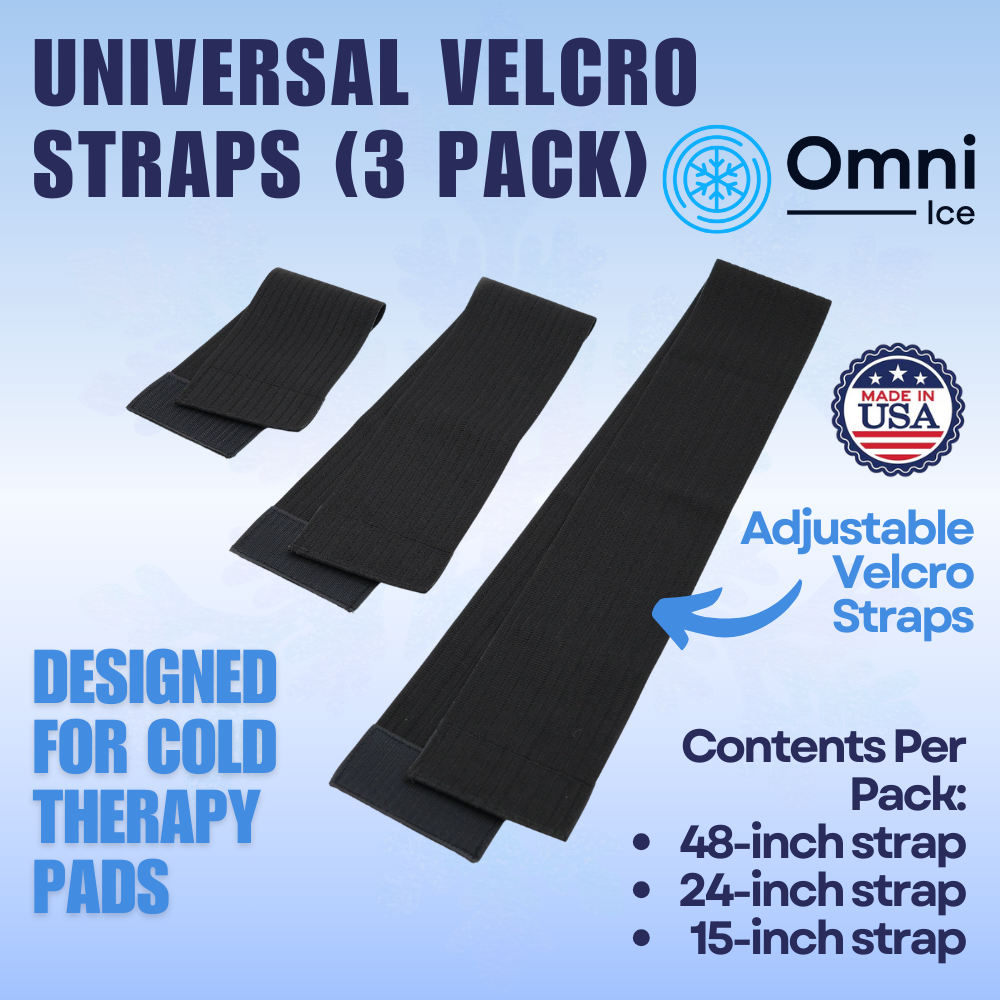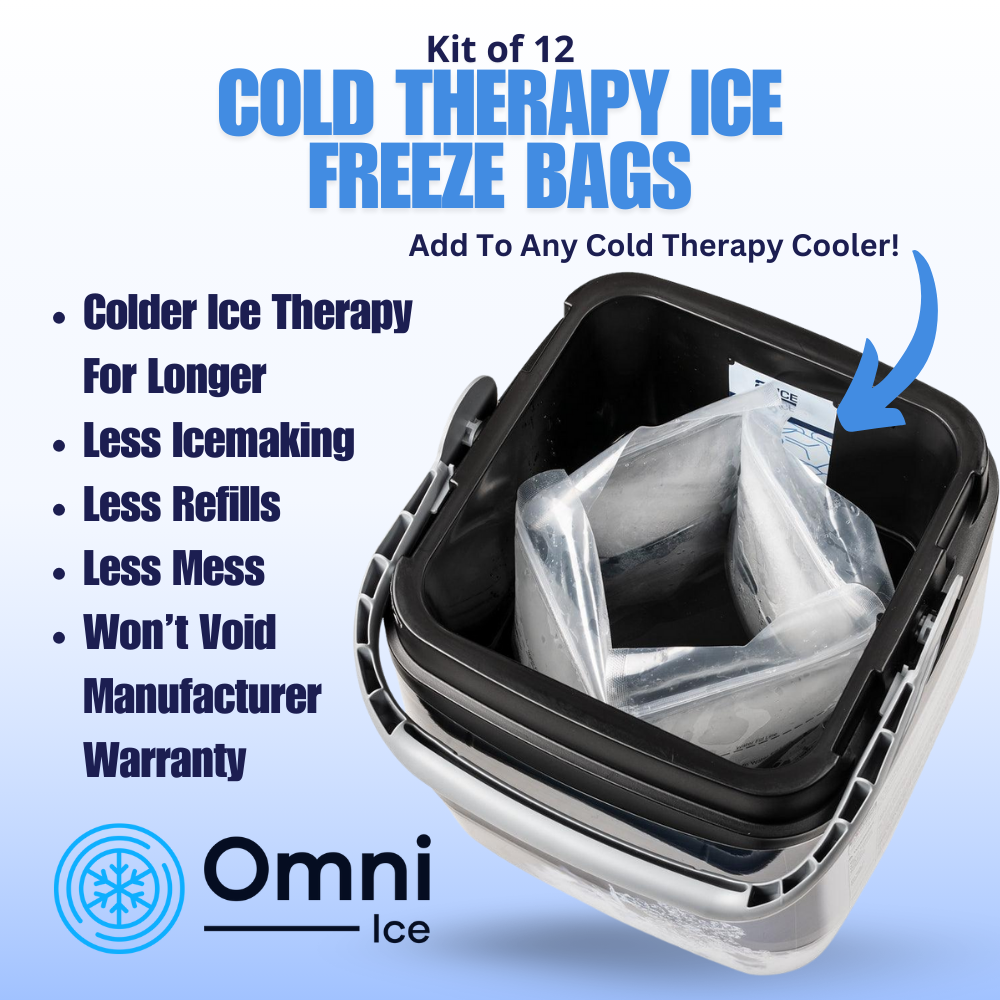Why Patients Choose Breg Glacier: A Deep Dive Into Post‑Operative Cooling
Why Patients Choose Breg Glacier: A Deep Dive Into Post‑Operative Cooling
After surgery, effective cooling can make the difference between a smooth recovery and lingering pain. This comprehensive guide explains what the Breg Glacier cold‑therapy system is, how it works and why so many patients prefer it for long‑lasting, comfortable post‑operative relief.
What Is the Breg Glacier and How Does It Work?
Cold therapy (cryotherapy) applies low temperatures to injured tissues to reduce pain and inflammation. The Royal Pharmaceutical Society notes that cryotherapy should be used soon after an injury to control swelling and is often applied immediately after surgery or trauma. Its mechanism involves vasoconstriction, which decreases blood flow and metabolic rate, slowing the inflammatory process and reducing pain signals.
The Breg Glacier is a motorised cold‑therapy system designed for post‑operative and injury recovery. Unlike simple ice packs, it circulates chilled water through a wrap‑on pad using a whisper‑quiet pump. The high‑capacity 11‑quart cooler holds enough ice and water to deliver up to 13 hours of therapy, and high flow rates ensure even temperature distribution across the pad. Temperature control allows clinicians to tailor the cooling intensity, and the device is built for hospital‑grade durability. Because continuous cold therapy can be potent, federal law restricts the Glacier to sale by or on the order of a medical professional.
The system works by filling the cooler with ice and water, which the pump circulates through a closed‑loop pad. Wrap‑on pads are available for the knee, shoulder, hip and other areas (see the pad table below). The Glacier uses the same pads as the Polar Care Cube, making it easy to swap pads if you already own other Breg units. Because the chilled water is constantly moving, the temperature stays consistent without freezing tissues, providing a safer alternative to static ice packs.
Benefits & Risks of Post‑Operative Cooling
Benefits of cold therapy
- Analgesia and pain relief: Cold therapy numbs nerve endings and increases the pain threshold. Studies on post‑operative reconstruction found that local cooling reduces pain perception and increases pain tolerance. The Cleveland Clinic explains that ice provides analgesia by numbing pain signals and halting inflammation.
- Reduced swelling and inflammation: Cryotherapy decreases blood flow and metabolic activity in injured tissues. This helps limit edema, hematoma formation and muscle spasm, allowing the joint to move more comfortably.
- Less reliance on narcotics: Better pain control can reduce the need for opioid medications. Continuous cold therapy has been shown to slow secondary hypoxic injury and protect tissue, promoting natural healing while keeping patients comfortable.
- Improved mobility and function: By reducing swelling and pain, patients can begin physical therapy sooner and regain range of motion more quickly. Many users report that the Glacier’s even temperature distribution and whisper‑quiet pump help them rest more comfortably.
- Extended therapy time: The Glacier’s large capacity cooler delivers up to 13 hours of cold therapy, reducing the need for frequent ice changes and allowing overnight use under supervision. High flow rates and temperature control further increase nurse efficiency.
Potential risks and cautions
- Tissue damage from over‑cooling: Prolonged or excessive cold can cause vasoconstriction that leads to tissue death or nerve injury. Editorial commentary in the World Journal of Clinical Cases warns that prolonged icing may delay healing and even cause permanent nerve damage.
- Skin injury and frostbite: Ice therapy sessions should not exceed 20 minutes at a time for most injuries. Signs that you are icing too long include skin turning red or pale, itchiness or tingling sensations. Always place a cloth or barrier between the pad and your skin to prevent frostbite.
- Rare complications: Continuous cooling can lead to panniculitis, an inflammation of the subcutaneous fat. The Pharmaceutical Journal notes that cryotherapy near superficial nerves may cause nerve damage, and reported side‑effects of intense cooling include bradycardia, Raynaud’s phenomenon, cold urticaria, frostbite and slowed wound healing.
- Delayed healing: Because inflammation is part of the healing process, prolonged cold therapy might slow recovery if used beyond the acute phase. Use cold only in the initial days post‑injury and switch to heat or active movement once inflammation subsides.
- Not for everyone: People with diabetes, circulatory insufficiency, Raynaud’s disease, cold hypersensitivity or neuropathic disorders should avoid cold therapy or use it only under medical supervision. Children, older adults and people with poor sensation are more susceptible to cold injury.
Despite these risks, most complications are preventable when patients follow instructions, monitor their skin and use a barrier. Always consult your surgeon or physical therapist before starting cold therapy.
How the Breg Glacier Works & How to Use It
The Glacier combines a high‑capacity cooler, a whisper‑quiet pump and anatomically shaped pads to deliver continuous cold. Understanding how to set up and operate the device helps maximize benefits and prevent complications.
- Gather your equipment and prescription. Obtain the Glacier base unit or combination kit and the appropriate wrap‑on pad for your body part. Federal law requires a prescription, and you should receive instructions from your clinician.
- Prepare the cooler. Fill the 11‑quart reservoir with a mixture of ice and cold water up to the designated line. Using frozen water bottles instead of loose ice can extend therapy time and minimize mess. The large capacity allows the system to run up to 13 hours on a single fill.
- Attach the pad. Connect the wrap‑on pad’s hose to the cooler’s coupling until it clicks into place. Make sure the connection is secure to prevent leaks. The Glacier accepts the same pads as the Polar Care Cube, so you can repurpose existing pads if you own multiple units.
- Protect your skin. Place a thin sterile dressing, cloth or Breg insulation barrier between your skin and the pad. Both Breg and the Cleveland Clinic stress the importance of a barrier to prevent frostbite and skin burns.
- Secure the pad. Wrap the pad around the surgical site and fasten the straps. Pads are anatomically contoured for knees, hips, shoulders and other areas; choose a size that covers the joint without compressing blood flow. Never wrap so tightly that it creates numbness or tingling.
- Position the cooler. Place the cooler below the level of your limb or joint so gravity can assist circulation. Plug the unit into a standard outlet; some models offer a battery option (see the Kodiak comparison), but the Glacier relies on household power for steady flow.
- Start therapy. Turn on the pump and adjust the temperature control if available. High flow rates ensure even temperature distribution across the pad. Do not sleep during therapy and periodically check your skin for redness or numbness.
- Time your sessions. For general icing, physicians often recommend 20–30‑minute sessions followed by 1–2 hours off. Continuous cold therapy systems like the Glacier may run longer under supervision, but always follow your doctor’s instructions. Remove the pad immediately if you feel excessive cold, pain or numbness.
- Finish and clean. Turn off the pump before disconnecting the hose. Empty the cooler, clean it with mild soap and water, and allow all components to air dry. Do not share pads between patients to prevent infection.
Proper setup and monitoring help harness the Glacier’s benefits while minimising risk. If you experience unusual symptoms—such as burning, severe numbness or discoloration—stop the therapy and contact your healthcare provider immediately.
How Long and How Often Should You Use Cold Therapy?
Timing is critical in cold therapy. For traditional ice packs, the Cleveland Clinic cautions that icing sessions should not exceed 20 minutes. Longer exposures can trigger reactive vasodilation, undoing the benefits and risking frostbite. Most experts recommend 10–15‑minute sessions for small joints and up to 20 minutes for larger areas, repeated every one to two hours. Allow your skin to return to normal temperature between sessions.
Continuous cold therapy devices like the Glacier are engineered to maintain a safe therapeutic range while running for extended periods. The high‑capacity cooler and flow‑through design deliver up to 13 hours of cooling, which is particularly useful for overnight recovery in a hospital or at home under supervision. Nevertheless, clinicians often prescribe scheduled breaks to inspect the skin and tissue. Never sleep with the pad directly on your skin, and stop the machine if you notice signs of over‑cooling (pale skin, tingling, or pain).
How long you use the Glacier post‑surgery depends on your procedure and your provider’s protocol. Some surgeons recommend continuous cold therapy for the first 48–72 hours, followed by intermittent use during rehabilitation. Others may advise alternating cold and active motion or switching to heat once inflammation subsides. As always, follow your doctor’s orders and listen to your body.
Who Should—and Shouldn’t—Use the Breg Glacier?
Because the Glacier is a regulated medical device, it is intended for specific patient populations and conditions. Common indications include:
- Post‑operative recovery following knee, shoulder, hip or other joint surgeries
- Arthroscopic or reconstructive procedures
- Plastic and general surgical procedure
- Post‑trauma care and chronic pain management
- Physical therapy sessions where reducing pain and swelling improves range of motion
- Only licensed healthcare professionals can order the Glacier, and they will determine whether cold therapy is appropriate based on your medical history. While many surgical patients benefit from cold therapy, certain individuals should avoid or limit its use:
- Diabetes and circulatory insufficiency: Impaired circulation increases the risk of tissue damage. Breg warns that cold therapy units should not be used by persons with diabetes or Raynaud’s disease, and the Pharmaceutical Journal echoes that caution.
- Cold hypersensitivity or allergy: Conditions such as cold urticaria or cold‑induced panniculitis can be triggered by cryotherapy.
- Nerve disorders or poor sensation: People with neuropathy may not feel early signs of frostbite. The Cleveland Clinic notes that individuals with nerve damage should shorten icing time or avoid cold therapy.
- Children and older adults: Thin skin and reduced body mass make these groups more susceptible to cold injury. Use only under direct supervision.
- Open wounds or skin conditions: Do not place cold pads over wounds, blisters or burns. Cryotherapy should not contact eyes or mucous membranes.
Always discuss your medical history with your provider before using any cold therapy system. If you develop unusual symptoms—such as an allergic reaction, extreme discomfort or skin changes—stop treatment and seek medical advice.
Product Options & Pad Compatibility
The Breg Glacier is sold as a base unit or as a combination kit that includes a pad and sterile dressing. Its large reservoir and high flow rates ensure consistent cooling. A temperature control knob allows clinicians to adjust the protocol for each patient. All pads connect via simple couplings, and the Glacier accepts the same wrap‑on pads used by the Polar Care Cubea. Below is a summary of available pads and their sizes:
| Pad type | Body area | Approx. size (inches) |
|---|---|---|
| Wrap‑On Knee | Knee (standard) | 10.25 × 11.25 |
| Wrap‑On Large Knee | Large knee | 11.5 × 12 |
| Wrap‑On XL Knee | Extra‑large knee | 12.25 × 19 |
| Wrap‑On Shoulder | Universal shoulder | 10.25 × 11.5 |
| Wrap‑On XL Shoulder | Large shoulder | 13 × 21.5 |
| Wrap‑On Hip | Hip | 11.5 × 12 |
| Wrap‑On Ankle | Ankle | 8.25 × 9.75 |
| Wrap‑On Back | Lower back | 8.25 × 11 |
Each pad should be used with a sterile dressing or insulation barrier to protect the skin. Pads are not interchangeable with non‑Breg units; using the wrong pad could damage your device or injure your skin. Always select the proper size and shape for your anatomy and follow your provider’s instructions.
Comparisons of Common Cold‑Therapy Options
There are several cold‑therapy devices on the market. The table below compares key features of the Breg Glacier and other popular units. Data for Glacier and Kodiak are taken from manufacturer product descriptions; information for other devices is general and may vary.
| Device | Therapy duration | Power source | Notes |
|---|---|---|---|
| Breg Glacier | Up to 13 h | AC power | Largest 11‑quart cooler; high flow rates and whisper‑quiet pump; uses Wrap‑On pads |
| Breg Kodiak | 6–8 h (battery pack provides 10–14 h) | AC or optional AA‑battery pack | Only portable battery‑powered option; Intelli‑Flo pads provide targeted temperature control |
| Breg Cube | ≈6 h (compact) | AC power | Smaller cooler; uses same Wrap‑On pads as Glacier; ideal for home use |
| Breg Wave | ≈6 h | AC power | Combines cold therapy with intermittent pneumatic compression to reduce edema; heavier and more expensive |
| DonJoy Iceman | 6–9 h | AC power | Popular non‑Breg unit; simple operation with moderate capacity; requires specific pads |
| Aircast Cryo Cuff | ≈6 h | Gravity‑fed (no pump) | Budget‑friendly; uses gravity to circulate water; limited flow and no temperature adjustment |
Choosing a device depends on your needs. If you want long‑duration therapy without re‑filling, the Glacier’s capacity and quiet operation make it appealing. The Kodiak is best for patients who need portability and battery power. The Cube is compact and shares pads with the Glacier, while the Wave adds compression for patients with significant swelling. Always discuss your options with your healthcare provider before purchasing.
Frequently Asked Questions
Do I need a prescription to purchase a Breg Glacier?
Yes. The Glacier is a Class II medical device, and federal regulations restrict it to sale by or on the order of a licensed medical professional. Your surgeon or therapist will determine whether it is appropriate for your recovery.
How long should I use the Glacier after surgery?
For most patients, clinicians recommend cold therapy during the first 48–72 hours after surgery, with sessions lasting up to 20–30 minutes and spaced one to two hours apart. Continuous devices like the Glacier can run longer under supervision, but you should follow the protocol set by your healthcare provider.
Is continuous cold therapy safe?
Continuous cryotherapy may protect tissue by slowing secondary hypoxic injury, but over‑cooling can harm nerves or delay healing. Use only as directed, check your skin frequently and remove the pad if you experience pain, numbness or skin discoloration.
Can I sleep with the Glacier running?
Sleeping while the unit is on is not advised. The Cleveland Clinic warns that falling asleep with an ice pack can lead to frostbite or nerve injury. If you plan to use the Glacier overnight, ask your provider for guidance and set alarms to check your skin.
How do I care for my pad and unit?
After each use, disconnect and drain the pad and cooler. Clean them with mild soap and water and let them air dry. Do not share pads between patients, and replace any pads that show signs of wear or damage. The Glacier uses the same pads as the Cube, so replacements are easy to find.
What if I have Raynaud’s or neuropathy?
Cold therapy may not be safe if you have conditions that impair circulation or sensation. People with Raynaud’s disease, diabetes, cold hypersensitivity or neuropathy should avoid cold therapy or use it only under close medical supervision.
Sources
Information in this article is drawn from peer‑reviewed research, major medical centres and manufacturer instructions. Key references include:
- Evaluation of the effect of cooling strategies on recovery after surgical intervention – open‑access study detailing how cryotherapy reduces local swelling and alters pain perception.
- Cleveland Clinic: How Long Should You Ice an Injury? – evidence‑based guidance on safe icing duration, the importance of a barrier and signs of over‑icing.
- The Pharmaceutical Journal: Thermotherapy and cryotherapy – overview of indications, contraindications and complications of cold therapy.
- ColdTherapyMachines.com – Breg Polar Care Glacier – product description providing details on high flow rates, whisper‑quiet pump and pad sizing.
- Breg Polar Care Glacier – manufacturer store – confirms up to 13 hours of therapy, need for an insulation barrier and prescription requirement.
- Living Well Stores – Breg Polar Care Kodiak – product page explaining Kodiak battery options, therapy duration and contraindications for patients with diabetes or Raynaud’s disease.
- World Journal of Clinical Cases editorial: Is it time to put traditional cold therapy out to pasture? – discusses controversies surrounding prolonged cryotherapy and potential nerve damage.








